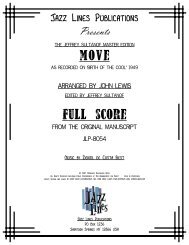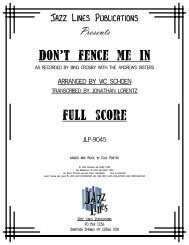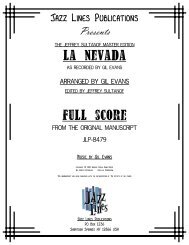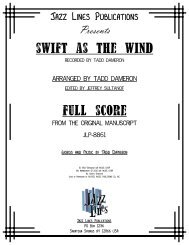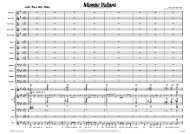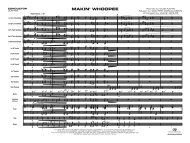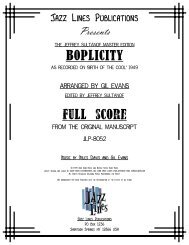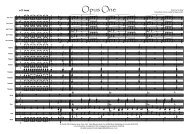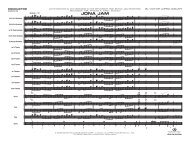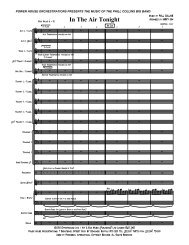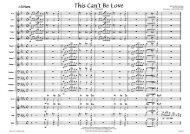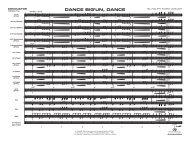wave_jlp-8666.pdf (223.95 KB) - Ejazzlines.com
wave_jlp-8666.pdf (223.95 KB) - Ejazzlines.com
wave_jlp-8666.pdf (223.95 KB) - Ejazzlines.com
Create successful ePaper yourself
Turn your PDF publications into a flip-book with our unique Google optimized e-Paper software.
Presents<br />
Jazz Lines Publications<br />
<strong>wave</strong><br />
Arranged by claus ogerman<br />
edited by rob duboff and jeffrey sultanof<br />
full score<br />
<strong>jlp</strong>-8666<br />
Music by Antonio Carlos Jobim<br />
Copyright © 1967 Corcovado Music<br />
All Rights Reserved. Used by Permission International Copyright Secured<br />
Warning: Unauthorized reproduction of this publication is prohibited by Federal Law and is subject to criminal prosecution.<br />
Logos, Graphics, and Layout Copyright © 2011 The Jazz Lines Foundation Inc.<br />
Published by the Jazz Lines Foundation Inc.,<br />
a not-for-profit jazz research organization dedicated to preserving and promoting America’s musical heritage.<br />
The Jazz Lines Foundation Inc.<br />
PO Box 1236<br />
Saratoga Springs NY 12866 USA
� Antonio Carlos Jobim series<br />
�<br />
<strong>wave</strong> (1967)<br />
Background:<br />
Antonio Carlos Jobim is considered one of the greatest songwriters of the twentieth century. He is a national hero in Brazil, where an airport and streets are named for him. His<br />
infl uence in the jazz world is overwhelming, and new recordings of his songs continue to increase in each passing year.<br />
Jobim, whose father was a diplomat, was born in 1927. Antonio grew up in Rio de Janeiro, and learned both the guitar and piano as a boy. He later said that he was infl uenced by<br />
Debussy and Ravel. He studied with a German piano teacher and was exposed to modern classical music.<br />
Although he briefl y studied architecture, he played piano in nightclubs, and eventually wrote arrangements for recording dates. In 1956, he met Vinicius de Moraes who had written<br />
a play based on the Orpheus legend. When Black Orpheus was made into a movie, Jobim wrote the score. Although it was based on the samba, the score had a harmonic richness<br />
previously unheard in Brazilian music. Jobim later told writer Gene Lees that he was infl uenced by Gerry Mulligan and other musicians who were playing what was called ‘cool jazz.’<br />
The new style was later dubbed ‘bossa nova’ (or ‘new <strong>wave</strong>’). Black Orpheus became very popular, and spread this new music around the world. Desafi nado (or Slightly Out of Tune)<br />
was soon recorded by many jazz artists.<br />
By the early 1960s, Jobim’s songs were being played and recorded by Herbie Mann and Stan Getz. In 1964, Jobim’s new song The Girl from Ipanema was recorded by Stan Getz with<br />
singer Astrud Gilberto (wife of Joao Gilberto). This single became an international sensation, and Jobim was soon making albums in the United States with arrangements by Nelson<br />
Riddle and Claus Ogerman. Other notable Jobim songs include Wave, How Insensitive, Quiet Nights, Meditation, and many others. Jobim made ten solo albums, and also recorded with<br />
Frank Sinatra and the equally legendary Elis Regina.<br />
Jobim remained active as a writer for the rest of his life, and occasionally toured, most notably in 1984 with his son Paulo playing guitar. He had a full schedule of new projects that<br />
he was preparing when, following surgery, he died of heart failure in 1994.<br />
As stated above, Jobim recorded now-classic albums with instrumental ac<strong>com</strong>paniment. With regard to the arrangers Jobim used for these recordings, Nelson Riddle was already<br />
a household name having made enormously successful albums with Frank Sinatra, Rosemary Clooney, and Dean Martin, as well as recordings under his own name. Claus Ogerman<br />
was less well-known at the time, but was a brilliant musician and <strong>com</strong>poser who has now worked in almost every genre of popular and concert music.<br />
Ogerman was born in Ratibor, Upper Silesia, and was fi rst known for his piano abilities. He wrote for the Kurt Edelhagen and Max Greger bands, and made many vocal records<br />
under the name Tom Collins. He moved to New York in 1959, and soon became a very busy free-lance arranger. Producer Creed Taylor hired him to arrange various jazz projects<br />
for Verve Records and he worked with artists including Bill Evans, Wes Montgomery, Kai Winding, and Cal Tjader. He later arranged for George Benson at Warner Brothers Records.<br />
Extremely prolifi c, it may never be determined exactly how many recordings he has made.<br />
Since the 1970s, Ogerman has be<strong>com</strong>e a successful <strong>com</strong>poser of concert music, writing song cycles, ballet music, symphonic music, and concerti for such artists as Bill Evans, Michael<br />
Brecker, and Aaron Rosand. However, he returned to arranging for pianist/vocalist Diana Krall in recent years.<br />
�
Thanks to an agreement with the Jobim Institute we are proud to make many of the arrangements from these albums available.<br />
The Music:<br />
According to the biography written by his sister Helena, the album Wave was largely <strong>com</strong>posed in the U.S. when Jobim was in California waiting to record with Frank Sinatra in 1967.<br />
Wave, Triste, and other classic instrumental <strong>com</strong>positions were created at this time as pieces which, according to his sister, “Refl ected very well his impressions of Los Angeles.” The<br />
album was recorded later in 1967 at Rudy Van Gelder’s legendary studio in New Jersey. Jobim had recorded there previously, and loved Van Gelder’s style, as well as the superior<br />
acoustics and equipment. The resulting album is a collection of songs which are among the best examples of the timeless beauty present in so much of Jobim’s work.<br />
Notes to the Conductor:<br />
Attempts to duplicate the sound on this and other Ogerman/Jobim albums will prove challenging even for the most advanced ensembles. We suggest extensive listening to the Jobim<br />
albums from this time period as Ogerman created an individualized sound all his own that is unlike other recordings. This arrangement was written to feature pianist Antonio<br />
Carlos Jobim along with trombone and alto fl ute. The direction to the trombonist to place his/her hand over the bell is important to follow. This is how Urbie Green and Jimmy<br />
Cleveland were able to achieve that remarkably soft and mellow horn sound. This arrangement may be opened up at measure 51 for additional solos. It appears that 12 violins and<br />
4 celli were used for the 1967 recording. We have included an optional synthesizer part so that this arrangement may be used without a string section. Lastly, for the guitarist we<br />
have transcribed the rhythms for the intro and fi rst 8 bars to give the appropriate feel. We suggest further study of the bossa nova style as the guitarist is the backbone of this arrangement<br />
and others in this series.<br />
Thank you for purchasing this publication and supporting our efforts.<br />
Jeffrey Sultanof, Rob DuBoff and Doug DuBoff<br />
- January 2012
<strong>jlp</strong>-8666<br />
Score<br />
FLute 1:<br />
Piccolo<br />
Flute 2:<br />
C Flute<br />
Flute 3:<br />
Alto Flute<br />
Trombone<br />
Violins<br />
Celli<br />
Guitar<br />
Piano<br />
Bass<br />
Drum Set<br />
Synth.<br />
�<br />
� � �<br />
�<br />
�<br />
� � �<br />
�<br />
�<br />
�<br />
�<br />
�<br />
�<br />
� �� �<br />
�<br />
�<br />
� � �<br />
�<br />
� �� �<br />
�<br />
�<br />
� � �<br />
�<br />
� �� �<br />
�<br />
� �� �<br />
�<br />
�<br />
�<br />
�<br />
� � �<br />
�<br />
� �� �<br />
�<br />
medium bossa nova � = 145<br />
�<br />
� � �<br />
� Û �<br />
Û �<br />
� Û<br />
� �<br />
Û<br />
� Û<br />
D>7 G7 D>7<br />
� Û �<br />
mf<br />
�<br />
�<br />
�<br />
�<br />
�<br />
�<br />
�<br />
�<br />
�<br />
�<br />
�<br />
�<br />
2<br />
� � � � � �<br />
� � �� � �<br />
�<br />
�<br />
�<br />
�<br />
� G7 �<br />
Û Û<br />
�<br />
�<br />
�<br />
�<br />
�<br />
�<br />
�<br />
mf<br />
mf<br />
Û �<br />
3<br />
�<br />
�<br />
�<br />
�<br />
�<br />
�<br />
�<br />
�<br />
�� � �<br />
�<br />
mf<br />
�<br />
�<br />
�<br />
�<br />
«<br />
�<br />
�<br />
�<br />
�<br />
�<br />
�<br />
�<br />
�<br />
� � ��� � �<br />
� � � � � ��<br />
4<br />
�<br />
�<br />
�<br />
�<br />
(2)<br />
‘<br />
�<br />
�<br />
�<br />
mf<br />
<strong>wave</strong><br />
Jazz Lines Publications<br />
Music by Antonio Carlos Jobim<br />
Arranged By Claus Ogerman<br />
Edited by Rob DuBoff and Jeffrey Sultanof<br />
�<br />
� �� � �<br />
mf<br />
hand over bell<br />
�<br />
� �� �<br />
5<br />
�<br />
�<br />
�<br />
�<br />
� �<br />
�� �<br />
�<br />
�<br />
�<br />
�<br />
‘<br />
�<br />
�<br />
�<br />
�<br />
«<br />
6<br />
�<br />
�<br />
�<br />
�<br />
�<br />
� ��<br />
�<br />
�<br />
�<br />
�<br />
� � �<br />
� � �<br />
�<br />
(4)<br />
‘<br />
�<br />
�<br />
�<br />
{S`o`l`o`}<br />
mf<br />
[7]<br />
�<br />
�<br />
�<br />
�<br />
�<br />
�<br />
Û �<br />
� Û Û<br />
� � � Û �<br />
D < 7 B<br />
Û<br />
�<br />
b�<br />
7<br />
�<br />
�<br />
�<br />
�<br />
�<br />
Û �<br />
� Û Û<br />
� � � Û �<br />
D<<br />
Û<br />
�<br />
7 Bb� 7<br />
�� � � D<<br />
��<br />
7<br />
7<br />
cross-stick<br />
{T`o`` `A`l`t`o` `F`l`u`t`e``}<br />
{T`o`` `A`l`t`o` `F`l`u`t`e``}<br />
�<br />
�<br />
yf y fy y y fy y y<br />
œ�<br />
œ œ�<br />
œ<br />
� �<br />
Copyright © 1967 Corcovado Music<br />
All Rights Reserved. Used by Permission International Copyright Secured<br />
Warning: Unauthorized reproduction of this publication is prohibited by Federal Law and is subject to criminal prosecution.<br />
Logos, Graphics, and Layout Copyright © 2011 The Jazz Lines Foundation Inc.<br />
Published by the Jazz Lines Foundation Inc., a Not-for-Profit Jazz Research Organization Dedicated to Preserving and Promoting America's Musical Heritage.<br />
mf<br />
�<br />
�<br />
� Û �<br />
� �� � �<br />
� Û �<br />
�<br />
�<br />
�<br />
�<br />
�<br />
�<br />
� Û � Û� Û �<br />
�<br />
� �<br />
� Û � Û� Û �<br />
B<br />
��� �<br />
��<br />
��<br />
b�<br />
7<br />
8<br />
sim.<br />
’ ’ ’ ’<br />
�<br />
�<br />
A>7<br />
Û Û<br />
�<br />
�<br />
�<br />
�<br />
�<br />
�<br />
�<br />
A>7<br />
Û Û<br />
�<br />
�<br />
A>7<br />
Û �<br />
Û �<br />
�<br />
�<br />
�<br />
�<br />
�<br />
�<br />
� Û �<br />
� Û �<br />
�<br />
� �<br />
� � �<br />
9<br />
’ ’ ’ ’<br />
�<br />
�<br />
D7 (b9)<br />
�<br />
Û<br />
�<br />
D7 (b9)<br />
�<br />
Û<br />
�<br />
�<br />
�<br />
� �<br />
� �
Jazz Lines Publications <strong>wave</strong><br />
<strong>jlp</strong>-8666<br />
Score - Page 2<br />
Fl. 3 (A. Fl.)<br />
Tbn.<br />
Gtr.<br />
Pno.<br />
Bs.<br />
D. S.<br />
�<br />
�<br />
� �� �<br />
� �<br />
�<br />
� �<br />
� �� � �� �<br />
10<br />
Û Û<br />
�<br />
�<br />
� � �<br />
Û Û�<br />
�<br />
D7 (b9)<br />
��<br />
�<br />
�<br />
� Û Û Û�<br />
�<br />
�<br />
� �<br />
� Û Û Û�<br />
�<br />
�<br />
� ��<br />
(4)<br />
’ ’ ’ ’<br />
G < 7<br />
Û Û<br />
�<br />
�<br />
�<br />
�<br />
G < 7<br />
Û Û<br />
�<br />
�<br />
�<br />
��<br />
�<br />
� �<br />
G < 7<br />
Û �<br />
Û �<br />
�<br />
�<br />
Û Û<br />
�<br />
�<br />
�<br />
� � �<br />
Û Û<br />
�<br />
�<br />
�� � � ��<br />
11<br />
’ ’ ’ ’<br />
G>6<br />
�<br />
Û<br />
�<br />
G>6<br />
�<br />
Û<br />
�<br />
�<br />
�<br />
Û Û<br />
�<br />
�<br />
�<br />
�<br />
� Û � Û� Û �<br />
� Û<br />
F # 13<br />
� � � �<br />
� � �<br />
�<br />
Û Û�<br />
�<br />
� Û � Û� Û �<br />
�� � � G>6<br />
��<br />
12<br />
’ ’ ’ ’<br />
� Û<br />
F # 13<br />
�<br />
�<br />
�<br />
Û<br />
�<br />
�<br />
Û<br />
F # 13<br />
��<br />
13<br />
�<br />
�<br />
F<br />
Û<br />
�<br />
Û Û Û<br />
# 7 (# 5) F # >7<br />
F<br />
Û<br />
�<br />
Û Û Û<br />
# 7 (# 5) F # >7<br />
F<br />
�<br />
� ��<br />
# 7 (# 5)<br />
’ ’ ’ ’<br />
�<br />
�<br />
Û Û<br />
� �<br />
� � ��<br />
Û Û<br />
F # >7<br />
��<br />
14<br />
�<br />
�<br />
Û Û<br />
�<br />
�<br />
� Û<br />
B7 (b9) E7<br />
�<br />
� �<br />
�<br />
�<br />
Û Û<br />
�<br />
�<br />
� Û<br />
B7 (b9) E7<br />
B7 (b9)<br />
�<br />
� �� � � �<br />
(8)<br />
’ ’ ’ ’<br />
� �<br />
Û Û<br />
�<br />
�<br />
�<br />
ÛÛÛ Û<br />
�<br />
� � � � � � � �<br />
� �<br />
Û Û<br />
�<br />
ÛÛÛ Û<br />
�<br />
�<br />
� �<br />
� � �<br />
E7<br />
15<br />
’ ’ ’ ’<br />
�<br />
�<br />
�<br />
�<br />
�<br />
Û Û �<br />
� Û B<br />
�<br />
Û�<br />
b7 A7<br />
�� � ��<br />
��<br />
�<br />
� �<br />
�<br />
Û Û �<br />
� Û B<br />
�<br />
Û�<br />
b7 A7<br />
B<br />
���<br />
� ��<br />
�<br />
b7 A7<br />
16<br />
’ ’ ’ ’<br />
�<br />
�<br />
� �<br />
�<br />
�<br />
�<br />
� �� �<br />
�� � �<br />
� �<br />
D>7 G7<br />
17<br />
’ ’ ’ ’<br />
�<br />
�<br />
� � �<br />
� � �<br />
� �� � � �<br />
Û �<br />
Û �<br />
D>7 G7<br />
� �<br />
D>7<br />
Û Û Û � Û Û Û Û Û<br />
� � � �<br />
G7<br />
� � Û Û Û Û Û<br />
Û �<br />
Û �<br />
D>7 G7 D>7<br />
� �<br />
Û Û Û � Û Û Û Û Û<br />
� � � �<br />
G7<br />
�� � �<br />
� �<br />
D>7 G7<br />
18<br />
(12)<br />
{S`o`l`i`}<br />
mf<br />
{S`o`l`i`}<br />
mf<br />
’ ’ ’ ’<br />
�<br />
�



